You’ve walked past countless buildings without knowing their stories, but some structures hide deeper mysteries in the shadows of tourist maps. These forgotten marvels exist as spaces carved from mountains, buried beneath cities, or rising from impossible places where ordinary ground transforms into something touched by magic.
Whether it’s a hand reaching from desert sand or an entire city tunneled beneath your feet, these gems reveal how humans have always found remarkable ways to leave their mark.
13. Meroe Pyramids, Sudan

The pyramids of Meroe rise from northern Sudan’s desert as remnants of the Meroitic civilization that flourished from 800 BCE to 350 CE. These steep structures measure only 20 to 30 feet across—more intimate than their Egyptian cousins—with unidentified burial chambers whose occupants remain lost to time.
One tomb’s central sarcophagus was deliberately shattered, its contents scattered for reasons that remain unclear, whether from overthrow or simple negligence. The pyramids stand as a testament to kingdoms that controlled Nubian gold and trade routes, reminding us that many of history’s intriguing stories remain buried beneath the sand or behind dangerous tourist attractions.
12. Balaklava, Ukraine

Object 825 GTS appears ordinary from the outside, which was exactly the point during the peak of the Cold War’s paranoia. Completed in 1961, this Soviet submarine base could withstand direct nuclear blasts with ten-meter-thick reinforced concrete walls protecting submarines entering through hidden waterways invisible to detection.
Radiation shielding and pressure-resistant bulkheads created an underground fortress signifying Soviet military ambitions and fears. Balaklava reveals the extraordinary lengths nations took to hide their most sensitive operations, where engineering became a Cold War mentality made concrete through survival via invisibility.
11. Gilmerton Cove, Scotland

Blacksmith George Paterson is said to have carved these tunnels beneath Edinburgh in the 1720s, but the reason for this remains unknown. Some claim it was a drinking den, others insist it was a secret temple, while the hand-carved sandstone chambers suggest an elaborate purpose beyond simple shelter.
Multiple rooms connect through narrow passages with benches lining walls and blocked tunnels hinting at larger networks. Ground Penetrating Radar in 2013 revealed even more hidden passages snaking through rock, making Gilmerton Cove one of those compelling mysteries that refuse to be solved.
10. Hand of the Desert, Chile
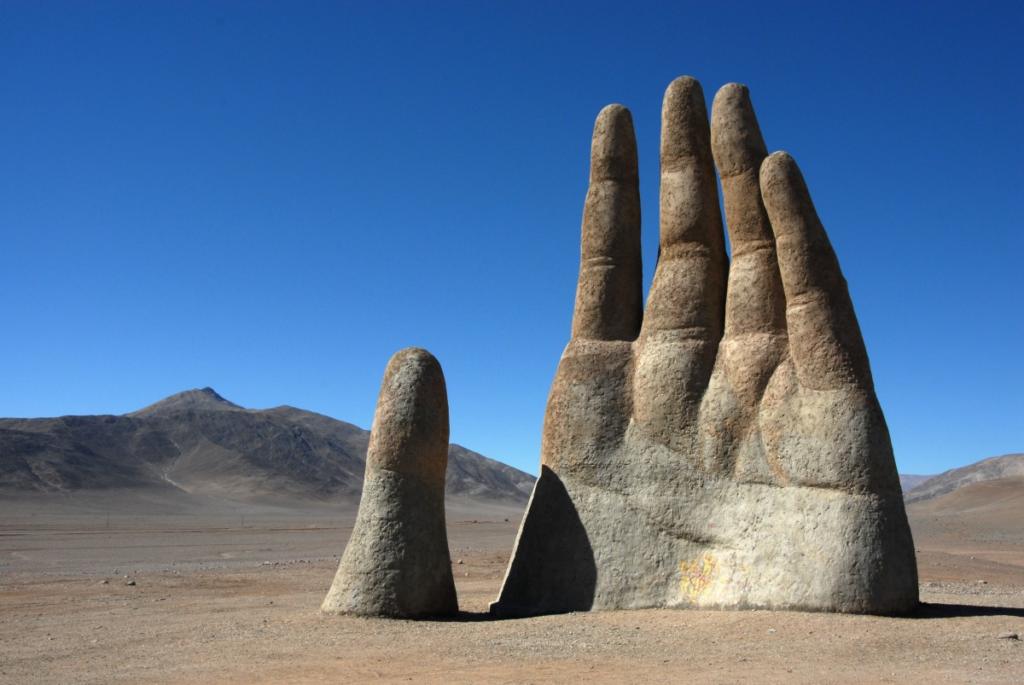
The Atacama Desert stretches endlessly, receiving less rainfall than anywhere else on Earth. From this brutal expanse, Mario Irarrázabal’s “Hand of the Desert” erupts—36 feet of concrete and iron fingers clawing at the sky.
Commissioned by Corporación Pro Antofagasta in 1992, this sculpture transforms barren nothingness into something that stops you in your tracks. Its open palm faces the heavens, as if catching stars, serving as a memorial to suffering and injustice while contrasting human fragility with nature’s permanence.
9. Tash Rabat, Kyrgyzstan
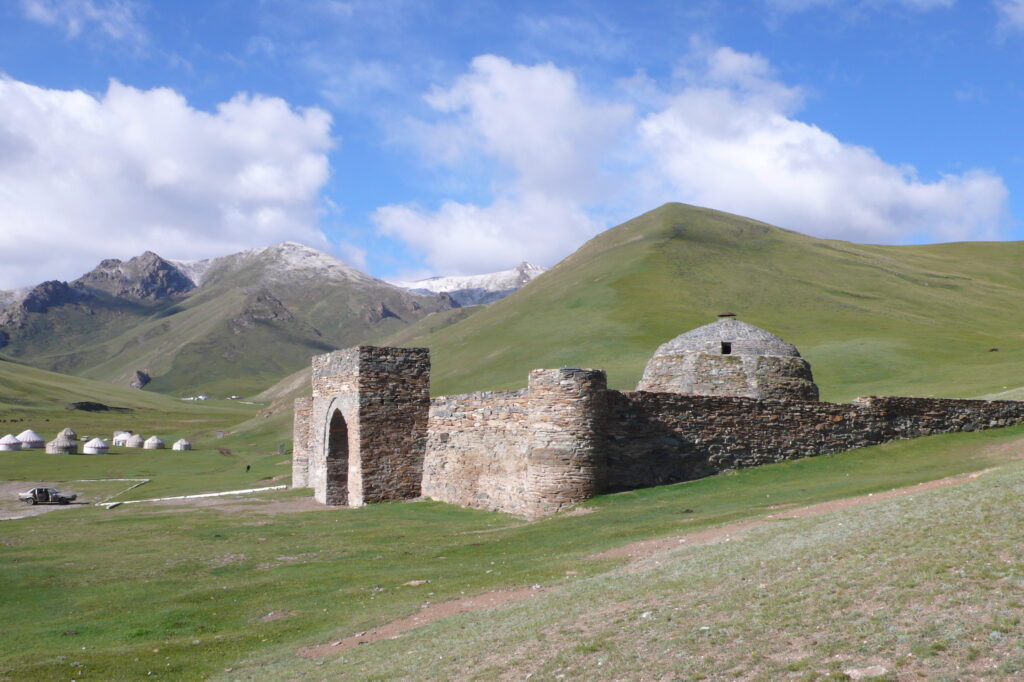
Kyrgyzstan’s Tian Shan mountains shelter a 15th-century architectural enigma at 11,500 feet—a dome-shaped stone structure comprising 28 vaulted chambers, the purpose of which historians still debate. Nobody agrees on its original purpose—some suggest it served Silk Road travelers as a caravanserai, while others propose it was a monastery or military outpost.
The structure’s remote location poses more questions than its architecture answers, requiring enormous effort for stone construction at such elevation. Analyzing Tash Rabat’s design provides clues about medieval Central Asian building techniques, although future archaeological work may ultimately reveal whether this fortress sheltered traders, monks, or soldiers.
8. Rocca Calascio, Italy
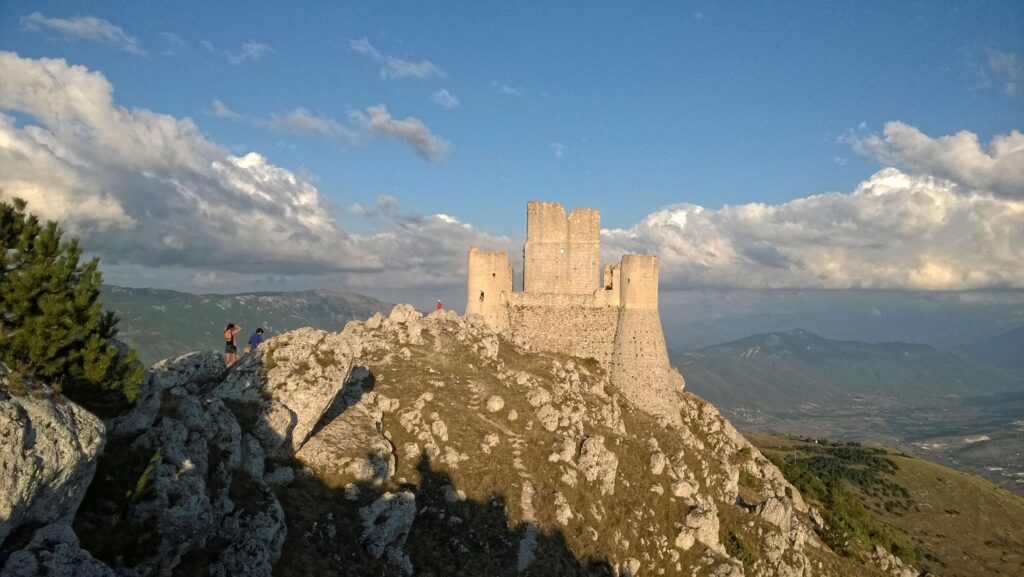
Medieval Italy carved Rocca Calascio into the Abruzzo mountains at an elevation of 4,800 feet, beginning in the 10th century before expanding into a four-towered stronghold that mountain harshness eventually claimed by the 1700s. The location served as a backdrop for the 1985 film “Ladyhawk,” introducing its dramatic silhouette to wider audiences seeking spiritual significance.
Visiting Rocca Calascio feels like stepping into history’s quiet moments with stunning views that evoke the kind of silence that makes you consider time’s passage. The fortress represents a place where earth meets sky in perfect solitude.
7. Kalakmul, Mexico

The Yucatan jungle keeps its secrets well, hiding Kalakmul—a Mayan city dominated by Structure 2, a pyramid commanding 150 feet of height and 400 feet of base width. Built during the late Classic period, showcasing the powerful Snake dynasty’s architectural ambitions, the humid air hangs thick around dual pyramid layouts, revealing sophisticated engineering.
Jungle vines now claim walls that once echoed with ceremonies and political intrigue. Exploring Kalakmul means pushing through vegetation to find stones that watched empires rise and fall, proving even the mightiest civilizations can be swallowed by green.
6. Derinkuyu, Turkey

A homeowner renovating his basement in 1963 broke through a wall and discovered an entire underground city. Derinkuyu burrows 18 stories deep beneath Cappadocia’s landscape, engineered to shelter up to 20,000 people with ventilation shafts plunging 180 feet down and rolling stone doors sealing passages like ancient security systems.
The city included everything needed for long-term survival—stables, kitchens, schools, churches, and armories. Derinkuyu proves that when faced with threats, humans don’t just adapt—they disappear entirely, creating hidden worlds beneath the ones everyone can see.
5. San Juan Parangaricutiro, Mexico
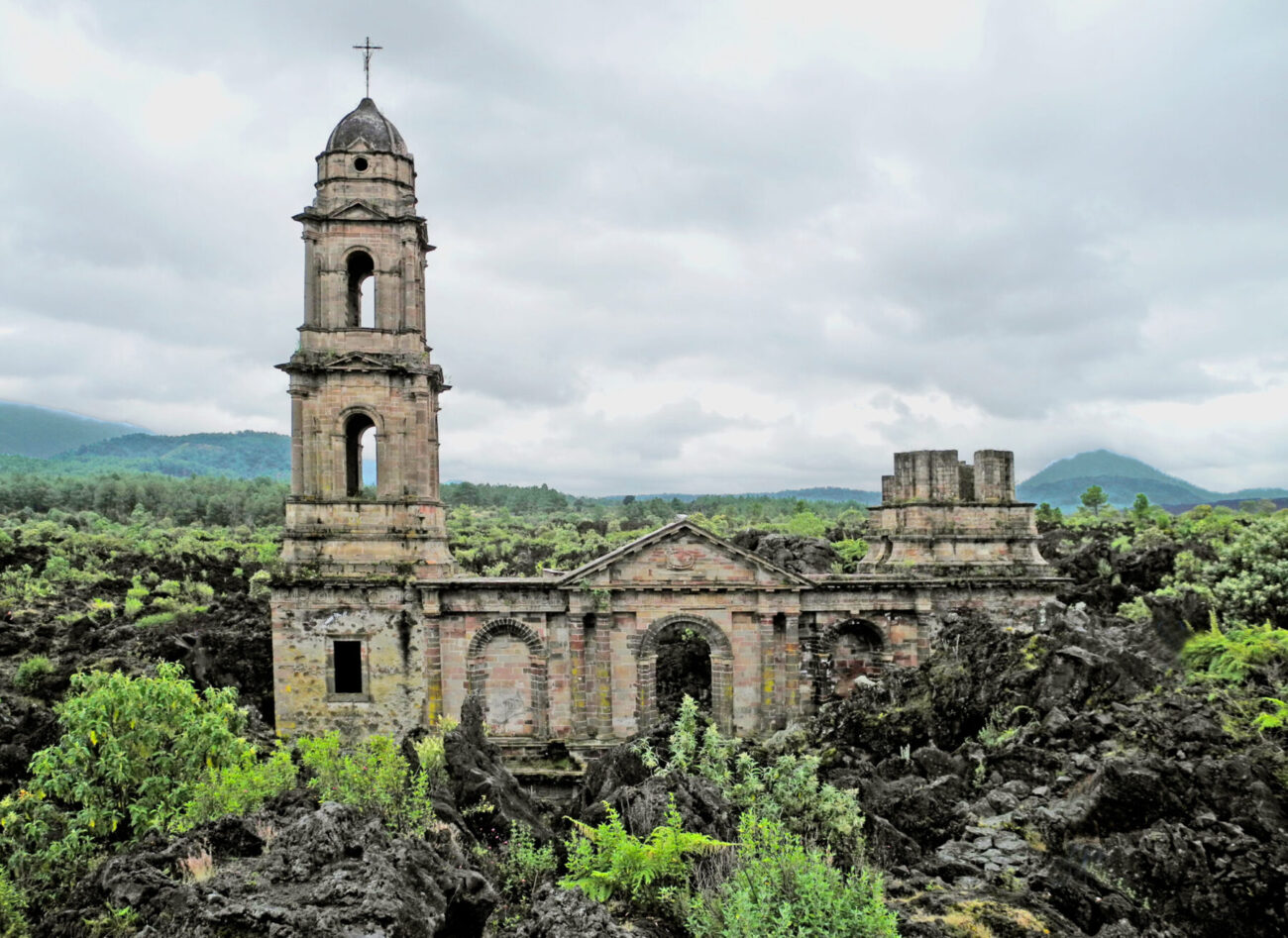
In February 1943, Mexico’s youngest volcano emerged from a cornfield, and Paricutin buried two entire towns under 30 feet of lava before ceasing in 1952. The church of San Juan Parangaricutiro survived—not through divine intervention, but because it sat on slightly higher ground in an altered landscape.
The church tower now rises from hardened lava fields like a stone lighthouse in a black sea, creating a powerful symbol where tragedy and hope intersect. Its survival serves as an emotional reminder of humanity’s capacity to endure natural disasters through chance geography rather than miracles.
4. Labyrinth of Hawara, Egypt

Ancient sources described a magnificent structure beside Amenemhat III’s pyramid—a labyrinth containing 3,000 rooms, half above ground, half below. British archaeologist Flinders Petrie began excavations in the 1880s, finding only fragments of what once inspired awe across the ancient world.
Ground-penetrating radar in 2008 revealed massive rectangular anomalies measuring 300 by 250 meters underground, confirming substantial buried structures remain. The ancient labyrinth represented knowledge and power in stone form, though now only traces survive proving even magnificent human achievements crumble into mystery.
3. Great Banyan Tree, India
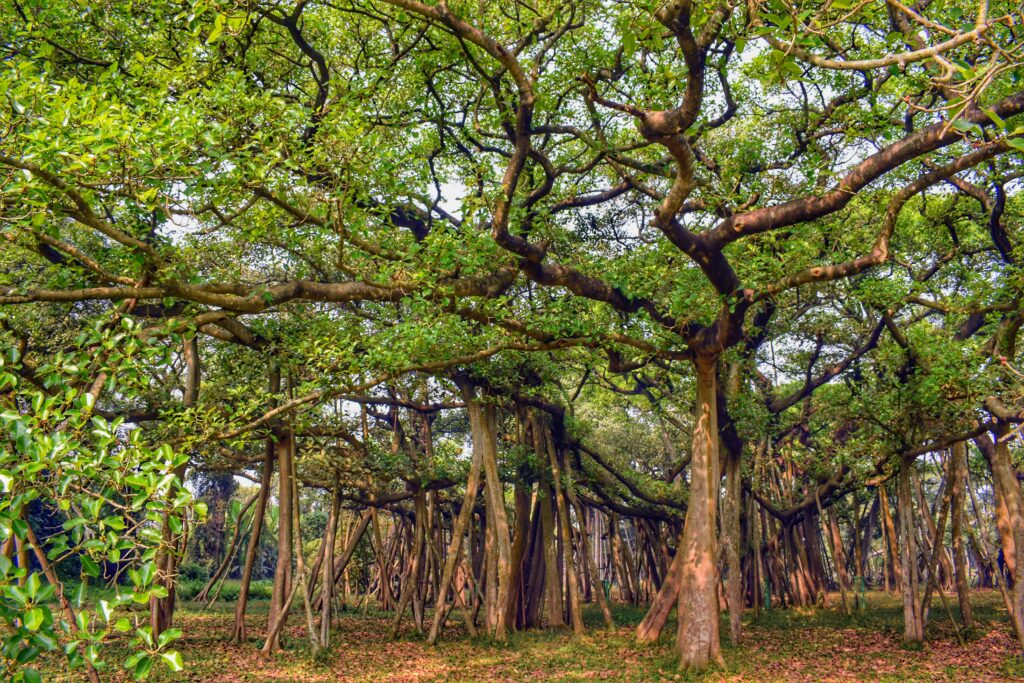
West Bengal’s botanical wonder defies conventional tree biology, spreading across three acres through 3,000 aerial root columns that replaced the long-deceased original trunk. Thousands of hanging roots create a natural cathedral where forest meets sacred space, housing a shrine that pays homage to spiritual essence.
The tree breathes life into regeneration concepts—dying at the center while expanding at the edges—where local beliefs hold that forest deities provide sanctuary. The Great Banyan symbolizes nature’s ability to become its own temple, demonstrating how biological architecture can inspire reverence without human intervention.
2. Pyramiden, Svalbard, Norway
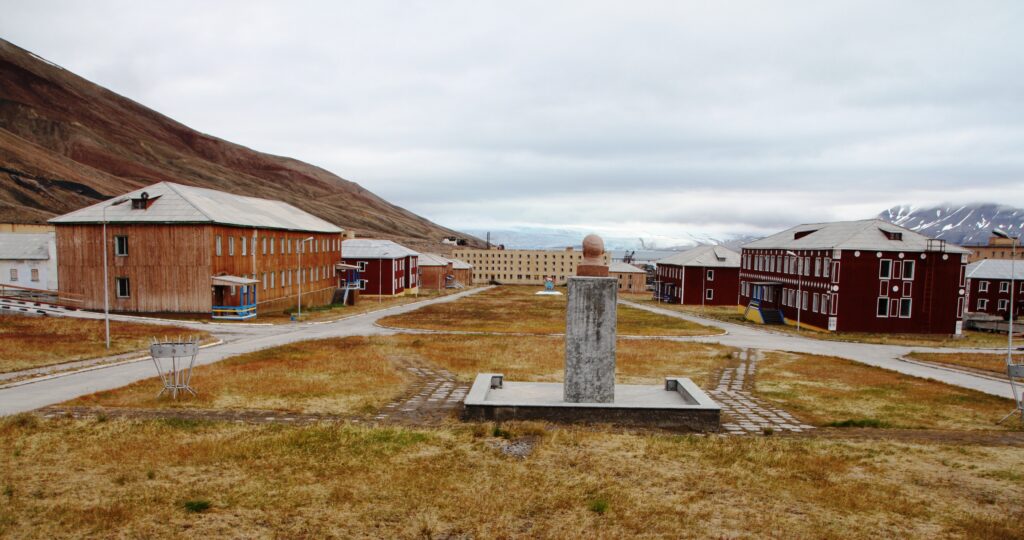
Sweden founded this Arctic town in 1910, then sold it to the Soviet Union in 1927 before everyone vanished in 1998. The Arctic’s dry freeze turned abandonment into preservation, leaving behind a perfectly intact Soviet time capsule where books remain open on tables and records still spin in empty rooms.
Small tourism facilities reopened in 2013, drawing visitors to witness how quickly civilization becomes a museum. Much like the forgotten 70s steakhouses that evoke nostalgia for a vanished era, Pyramiden’s empty dining halls and communal spaces offer a haunting glimpse into a world left behind.
1. Dar al-Hajar, Yemen

Imam Yahya looked at a 50-foot rock outcrop in the 1930s and saw potential for a summer palace. Workers completed the five-story Dar al-Hajar using traditional Yemeni techniques—thick stone walls for insulation and rainwater collection systems for survival, evolving from what locals considered a sacred site.
Traditional architectural methods shaped every detail, from carved windows to interior courtyards, preserving ancient building wisdom despite Yemen’s contemporary challenges. The palace demonstrates how the right location and skilled hands can transform raw stone into something exceptional that bridges heritage with innovation.


















